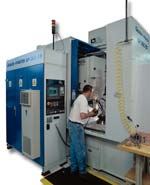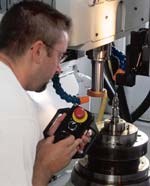Casting For Customers
Gear shaping is a vital capability for job shops because it gives them the ability to handle jobs that can't be hobbed efficiently, like spur gears with narrow face widths, gears with close shoulders and the majority of internal gears.
Share





Take a walk down one of the aisles at Forest City Gear (Roscoe, Illinois) and you will see everything from a single Martian "Rover" vehicle part being hobbled to quality levels of AGMA Class 12 to thousands of production parts. Owner Fred Young says his company's investment in new equipment gives it a competitive edge in parallel-axis or worm gear projects up to 450 mm diameter.
In fact, Mr. Young invests in new equipment regardless of business conditions. Most years, he pours some 25 to 40 percent of his precision job shop's gross sales revenue back into new equipment. He says this approach has been profitable for his company.
Gear shaping is a vital capability for job shops such as Forest City Gear because it gives them the ability to handle jobs that can't be hobbed efficiently, like spur gears with narrow face widths, gears with close shoulders and the majority of internal gears. But many of these gears are helical, requiring that an additional rotary motion be superimposed on the cutting stroke to produce the necessary right-hand or left-hand helix angle in the gear. Traditionally, and even on Mr. Young's most modern CNC gear shapers, this motion is created by a mechanical guide that must be manufactured with both lead and "hand" identical to that of the shaper cutter being used to produce a particular helix angle.
Thus, each new helical gear requires the production of a new mechanical guide, a process that can take upwards of 20 weeks and cost as much as $12,000 for each new guide. Then there's the hour or more required to change guides, the inability to make even the slightest lead changes, the impossibility of processing gears with different leads in a single setup and so on.
However, since taking delivery of the GP 300 ES CNC shaping machine from Gleason (Love's Park, Illinois), Forest City Gear has eliminated all of these problems and opened the door to many new gear-shaping opportunities. For example, the company was able to win an order for just eight prototype automotive helical pinions, shape them to an AGMA Class 11 quality level and have them back in the customer's hands just 2 days after receiving the blanks.
They also bailed out a competitor who had mistakenly ordered the wrong-fitting guide for a particular helical gear application. Forest City Gear turned it around in days, saving their rival thousands in replacement guide costs and taking weeks off delivery.
Then there was the customer who needed an internal 24-pitch, 230-tooth gear ground to AGMA Class 12. Mr. Young convinced the customer that he could save thousands of dollars by instead shaping it on the GP 300 ES. Accuracies were met, and an original order for five or six gears soon turned into one for 20 to 30.
The GP 300 ES offers an infinitely variable guide capability without the use of any additional mechanical components such as gear drives. It features a new shaping head design with a backlash-free direct drive for the cutter spindle. Under CNC and with the appropriate software, the additional "twisting" motion to produce a helical gear is superimposed electronically on the cutter spindle as it rotates. All gear cutting, tooling and part parameters (including the helix angle to be shaped) are simply entered into a user-friendly dialog program, and the CNC controller calculates all the necessary machine data/settings automatically.
Benefits to users such as Forest City Gear include the elimination of the lengthy lead times and cost required to purchase mechanical guides as well as the time-consuming, and in some cases difficult, changeover of guides. In addition, the electronic helical guide enables lead angle corrections to be made from one part to the next. Lead angle errors that result from the "unwinding" or straightening effect often caused by heat treat, for example, can be compensated for. Even helix angles more than 45 degrees—extremely small leads for external or internal gears—can be produced. Using tandem tools, even gears with different helix angles/directions can be produced in a single setup. Actual shaping cycle times on the electronic helical guide are virtually identical to times on its mechanical counterpart.
Mr. Young believes that these benefits will pay back the slight premium he paid for the GP 300 ES versus a conventional CNC shaping machine—probably in just five different gear applications or less. Not that he's concerned about the short term. "We buy machines with all the bells and whistles," he says. "A lot of companies go with a cheaper machine thinking they've saved $100,000.
"But what does 100K mean spread over the useful life of a machine? It's pretty inconsequential, especially since I'm buying a better machine for the long-term benefits of technology, service, support and quality. Those who are driven by simply price and cost will certainly lose in the long run."
Read Next
Setting Up the Building Blocks for a Digital Factory
Woodward Inc. spent over a year developing an API to connect machines to its digital factory. Caron Engineering’s MiConnect has cut most of this process while also granting the shop greater access to machine information.
Read MoreRegistration Now Open for the Precision Machining Technology Show (PMTS) 2025
The precision machining industry’s premier event returns to Cleveland, OH, April 1-3.
Read More5 Rules of Thumb for Buying CNC Machine Tools
Use these tips to carefully plan your machine tool purchases and to avoid regretting your decision later.
Read More





















.jpg;maxWidth=300;quality=90)









